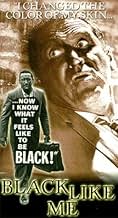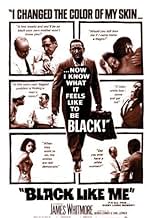Aggiungi una trama nella tua linguaBased on the true story of a white reporter who, at the height of the civil-rights movement, temporarily darkened his skin to experience the realities of a Black man's life in the segregated... Leggi tuttoBased on the true story of a white reporter who, at the height of the civil-rights movement, temporarily darkened his skin to experience the realities of a Black man's life in the segregated South.Based on the true story of a white reporter who, at the height of the civil-rights movement, temporarily darkened his skin to experience the realities of a Black man's life in the segregated South.
- Regia
- Sceneggiatura
- Star
- Premi
- 1 vittoria in totale
Lenka Peterson
- Lucy Horton
- (as Lenka Petersen)
P. Jay Sidney
- Frank Newcomb
- (as P.J. Sidney)
Recensioni in evidenza
Unfortunately, the quality of this movie was hindered by the poor production values of the period, as well as a low budget. This is the true story of John Howard Griffin (in the movie referred to as John Finley Horton, a Caucasian man who cared enough about the issues of racism that he put himself and his family in danger by posing as an African American man who traveled through the then racist Deep South of the United States in the late 1950's. The movie does not entirely succeed in capturing the terror, the weariness, the lack of dignity, and the outright hatred experienced by the lead character simply because of the color of his skin. However, seeing this movie should stimulate one's curiosity enough to read the book, one of the best and most disturbing I have ever read and whose message is still relevant today And for those of you poor souls who believe that this movie is little more than an example of "reverse racism," I suggest you consult a dictionary because there is no such term.
For you people who don't know. This movie is based on a book by John Howard Griffin. In real life he dressed like a black man in 1959 and went about in Mississippi for five or six weeks. During this time he also went as himself a white-man, in order to compare certain scenarios. He was treated differently as a black man because that is how the white people decided to treat him. Not because he told them to, not because he did anything wrong. That's just how he was treated. The movie just happens to show what his experiences were. For all the people who believe racism doesn't exist just because they aren't racist (or at least said anything racist out loud) you aren't living in reality or at least America. True it isn't as blatant now as it was then it is real. So if you don't like this movie fine. But don't let your ignorance of how the world (or at least America)works be your reason for not liking this movie.
This is the sleepy South as it really was. The pace is deliberate but necessarily so. The direction and acting is gritty and real.
The anger was real. The prejudice was real. The hate was real. The fear was real. The pain was real. It really happened this way.
This movie shows us all that. We walk in the shoes of a white man who looks like a black man...but we will never know. We can only imagine like James Whitmore's character, John Horton. We can only imagine what a man or woman had to endure in the unilluminated history of the United States.
Seeing this, we know, though we have come quite some distance, that we have still a long way to go before the reality is but a memory.
I salute all of those involved in this film and Mr. John Howard Griffin who endured it all and let us know the cruelty of man and helped us open our eyes.
The anger was real. The prejudice was real. The hate was real. The fear was real. The pain was real. It really happened this way.
This movie shows us all that. We walk in the shoes of a white man who looks like a black man...but we will never know. We can only imagine like James Whitmore's character, John Horton. We can only imagine what a man or woman had to endure in the unilluminated history of the United States.
Seeing this, we know, though we have come quite some distance, that we have still a long way to go before the reality is but a memory.
I salute all of those involved in this film and Mr. John Howard Griffin who endured it all and let us know the cruelty of man and helped us open our eyes.
The person who claimed this is a movie about "reverse racism" must be so young that he can't remember those times. I grew up in the 50's and 60's in the south. The movie portrays the prevailing attitude of whites toward blacks in an accurate manner. I can remember the separate waiting rooms, water fountains, "white only," etc. Thankfully, I grew up in a home where racial prejudice was not tolerated, and I'm sure there were a lot of homes like this.
In the book, Griffin passes through the same area as a black and then a white. The difference in his treatment was appalling. What the movie shows is that racial prejudice makes no sense. All people are simply people and deserve to be treated with respect.
In the book, Griffin passes through the same area as a black and then a white. The difference in his treatment was appalling. What the movie shows is that racial prejudice makes no sense. All people are simply people and deserve to be treated with respect.
This movie mostly follows the book closely, but Whitmore's performance gives it an altogether different tone. Instead of portraying Griffin's experience realistically, he's just angry throughout the film. As Griffin himself noted, that kind of behavior would never have been tolerated by the Southerners. Yet Whitmore blusters along, talking back and actually threatening at times. I found that this really detracted from the message of the book, and the film fails to convey the despondence that overcame Griffin after the full realization of his experiment. Whitmore also makes Griffin look naive, uneducated, and speaks in a grating northern accent. In conclusion, the film is okay, and relatively true to the book, if you ignore Whitmore's out-of-place angry delivery.
Lo sapevi?
- QuizGriffin actually went through the pigment darkening process twice. The first time was for his original article in Sepia Magazine. The second time was much later for the book, when he returned to some of the same locales to be photographed in character.
- BlooperWhen Horton, after meeting the PhD student, opens his wallet to pay in the diner, something falls out of it near the counter. No one notices or refers to it.
- ConnessioniFeatured in Classified X (2007)
I più visti
Accedi per valutare e creare un elenco di titoli salvati per ottenere consigli personalizzati
- How long is Black Like Me?Powered by Alexa
Dettagli
Botteghino
- Budget
- 273.000 USD (previsto)
- Tempo di esecuzione
- 1h 45min(105 min)
- Colore
- Mix di suoni
Contribuisci a questa pagina
Suggerisci una modifica o aggiungi i contenuti mancanti

































